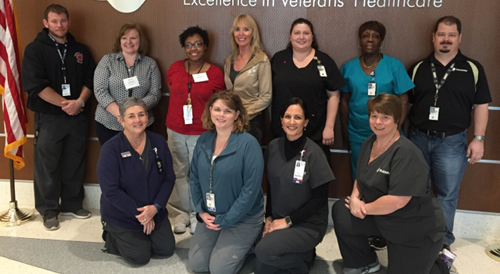National nursing service orientation course developed
By Lygia Arcaro, Ph.D, RN-BC
SimLEARN National Director for Nursing Programs
ORLANDO, Fla. – Two years ago, a team of subject matter experts from a variety of VHA facilities met to initiate the development of a national nursing service orientation course based on identified gaps and the need to standardize curriculum using simulation. This project recently went through a pilot stage evaluation at the Dayton VA Medical Center (VAMC) in Ohio and the VHA SimLEARN National Simulation Center here.
The training is designed to provide newly hired nursing staff like registered nurses, (RNs), licensed practical/vocational nurses (LPN/LVNs) and nursing assistants (NAs), opportunities to review nursing practice, utilize-facility specific equipment, as well as participate in the simulation-based scenarios in a safe learning environment. Representatives of all three nursing categories participated in the pilot evaluation. Development of the learning topics and initial scenarios was a multi–site process using nursing education teams from across VHA.
In 2015, the initial team completed their work refined the simulation scenarios after investigating VHA directives, evidence-based and best practices, accreditation requirements, and additional peer-reviewed articles.
Teamwork is essential in health care. For this reason, each of the 22 scenarios in the training solution places an emphasis on communication, collaboration and delegation where appropriate. Scenarios take place in both the inpatient and outpatient settings. Examples include patients with blood transfusion reactions, stroke symptoms, or patients receiving IV antibiotics therapy. Pain management, patients with falls and suicidal patients are topics also covered, simulated and debriefed.
Components, like learning objectives, scenario flowcharts, scripts, physician or advance practice nurse orders, diagnostic results and medical record documentation, are included for each scenario to improve learner immersion and improve training fidelity. Each scenario is comprised of a didactic portion to introduce the importance of the primary topic, discuss VHA directives, available resources and suggested techniques to implement current evidence-based practice. The didactic component allows for the addition of facility-specific policies and procedures providing an opportunity for the learner to experience a realistic simulation where they are able to perform the skills according to their scope of practice.
Some of the comments from the debriefings at Dayton included kudos for providing a “safe” learning environment to all; and a nursing assistant was glad to participate because in her role, it was helpful to have the same training as the licensed staff so that she can “best support the needs of the patient and staff during care and emergencies.”
The nursing orientation project’s overall goal is to increase confidence and abilities of VHA nurses, including those who recently entered VHA service, as well as individuals who have transitioned to new roles in caring for our Veterans in a standardized way. This program incorporates the VA I CARE core value principles and Veteran population specific training using evidence-based practices. Scenarios can be customized to meet each facility’s individual policies and procedures.
Ronnetta Blackwell, an LPN from the Columbus, Ohio VAMC participated in the pilot. She said, “adding more simulations we deal with daily in training would only improve the high level of care we already provide. Providing real actors really helped with the authenticity of each situation. I know we will continue to be at the forefront of quality patient care for our Veterans because we take the time to make sure our staff are properly trained.”

A variety of staff participated in a nursing orientation pilot held at the VHA SimLEARN National Simulation Center recently. (Front row, left to right) Susan Martenson, RN; Jane Robinson, RN; Debra Mosley, RN; and LeAnn Schlamb, RN, work at SimLEARN, as does Jimmy Bloodgood, simulation technician, and Daniel Desormeaux, project manager (second row, far left and far right). Standing between Bloodgood and Desormeaux are (left to right) Angela Choulat, LPN, and Ronnetta Blackwell, LPN, from the Columbus, Ohio VA Medical Center (VAMC); Diane Johnstone, RN, chief nurse, education, from the Bay Pines, Florida VAMC); and Janice Bradley, NA, and Leyna Bailey, NA, from the Battle Creek, Michigan VAMC. (VA photo by Ramon Garcia)
____________________________________________________________________________________



















